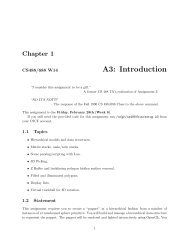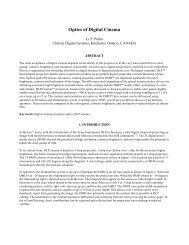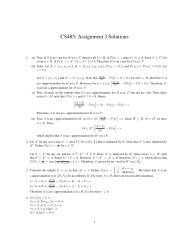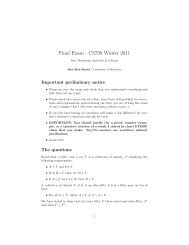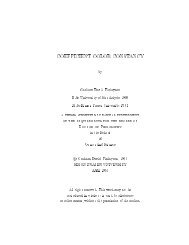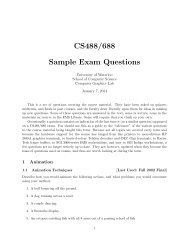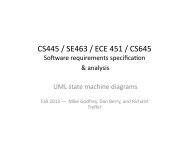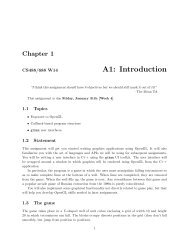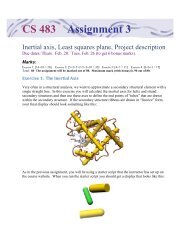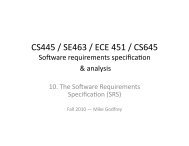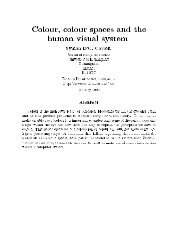Assignment 02 questions (PDF) - Student.cs.uwaterloo.ca
Assignment 02 questions (PDF) - Student.cs.uwaterloo.ca
Assignment 02 questions (PDF) - Student.cs.uwaterloo.ca
Create successful ePaper yourself
Turn your PDF publications into a flip-book with our unique Google optimized e-Paper software.
CS 116 Winter 2014!<br />
<strong>Assignment</strong> <strong>02</strong>!<br />
Due at 11:00am on Tuesday, January 28!<br />
• This assignment consists mostly of material from Module <strong>02</strong>, on functional<br />
abstraction and functions as values.<br />
• You must use abstract list functions (map, filter, foldr, build-list)<br />
where appropriate. You may use the function length.<br />
• <br />
For full marks, each question must use abstract list functions in a nontrivial<br />
way. You may NOT use explicit/structural recursion in any of your<br />
solutions. <br />
• For this assignment, unless otherwise noted, you <strong>ca</strong>nnot use named helper<br />
functions. This includes those that are defined outside of a function and those<br />
defined within a lo<strong>ca</strong>l. In essence you should only use lo<strong>ca</strong>l to define<br />
constants and you should use lambda for any functions.<br />
• You are expected to use the design recipe when writing functions from scratch.<br />
For lambda functions embedded in larger functions you do not need comments<br />
(i.e. contracts or purpose).<br />
• Do not copy the purpose directly from the assignment description. The purpose<br />
should be written in your own words and reference the parameter names of<br />
your functions.<br />
• The solutions you submit must be entirely your own work. Do not look up either<br />
full or partial solutions on the Internet or in printed sources.<br />
• Download the interface file from the course Web page.<br />
• Read the course Web page for more information on assignment policies and how<br />
to organize and submit your work. Follow the instructions in the style guide.<br />
Specifi<strong>ca</strong>lly your solutions should be placed in files a<strong>02</strong>qY.rkt where Y is a value<br />
from 1 to 4.<br />
• Read each <strong>questions</strong> <strong>ca</strong>refully for restrictions. Test data for all <strong>questions</strong> will<br />
always meet the stated assumptions for consumed values.<br />
• <strong>Assignment</strong>s will not be accepted through email. Course staff will not debug<br />
code emailed to them.<br />
• Read the assignment <strong>ca</strong>refully before asking any <strong>questions</strong> on Piazza.<br />
• You may want to review the string and characters resource on the course<br />
website.<br />
!<br />
Coverage: Module <strong>02</strong><br />
Language Level: Intermediate <strong>Student</strong> Scheme with lambda<br />
!<br />
1. A triangular number is one which represents the number of “balls” required to make an<br />
equilateral triangle. For example the numbers 1, 3 and 6 are the first three triangular<br />
numbers (note how they correspond to the images below).<br />
!<br />
!<br />
!<br />
k = 1; b = 1 k = 2; b = 3 k = 3; b = 6
CS 116 Winter 2014!<br />
<strong>Assignment</strong> <strong>02</strong>!<br />
Due at 11:00am on Tuesday, January 28!<br />
!<br />
!<br />
!<br />
!<br />
In general the number of balls b required to make a triangle with k rows is given by:<br />
(a)<br />
b = 1 + 2 + 3 + 4 + … + k = k(k+1)/2<br />
Use the formula above, k(k+1)/2, to write a Scheme function first-n-triangular<br />
that consumes a positive natural number n and produces a list of the first n triangular<br />
numbers.<br />
For example,<br />
(first-n-triangular 1) => (list 1)<br />
(first-n-triangular 4) => (list 1 3 6 10)<br />
!<br />
(b)<br />
!<br />
Write a Scheme function first-n-triangular—v2 that consumes a positive natural<br />
number n and produces a list of the first n triangular numbers. In this function you<br />
<strong>ca</strong>nnot use the formula k(k+1)/2.<br />
!<br />
2. (a) Write a Scheme function all-letters-sorted that consumes a list of lower<strong>ca</strong>se<br />
alphabetic strings los and produces a single string containing all of the letters in los<br />
ordered alphabeti<strong>ca</strong>lly.<br />
!<br />
For example,<br />
(all-letters-sorted (list "bob" "mob" "cob" "dave" "rob")) =><br />
"abbbbbcdemoooorv"<br />
!<br />
!<br />
!<br />
!<br />
Use the function sort in your solution. From the Racket reference:<br />
(sort lst less-than?) <br />
Returns a list sorted according to the less-than? procedure, which takes two elements of lst and returns a<br />
true value if the first is less (i.e., should be sorted earlier) than the second. <br />
!<br />
Examples:!<br />
> (sort '(1 3 4 2)
CS 116 Winter 2014!<br />
<strong>Assignment</strong> <strong>02</strong>!<br />
Due at 11:00am on Tuesday, January 28!<br />
!<br />
For example,<br />
(unique-letters-sorted<br />
(list "bob" "mob" "cob" "dave" "rob"))<br />
=> "abcdemorv"<br />
!<br />
3. Consider the new structure<br />
(define-struct lottery-ticket (game value))<br />
;; A Lottery-Ticket is a structure (make-lottery-ticket g v), where<br />
;; g is one of the symbols 'Keno, 'Powerball, 'Lottario,<br />
;; v is an integer representing the “earnings” on that ticket<br />
;;(earnings could be negative)<br />
!<br />
Write a Scheme function game-summary that consumes a symbol game and a list of<br />
Lottery-ticket structures, <strong>ca</strong>lled all-tickets, and produces a function. The<br />
produced function accepts a symbol (either 'won 'lost or 'net) and produces the total<br />
amount won, lost or net (see table below) for that particular game across all tickets.<br />
!<br />
Value<br />
Meaning<br />
won<br />
lost<br />
sum of all positive earnings<br />
absolute value of the sum of all negative earnings<br />
net<br />
won - lost (i.e. total value)<br />
!<br />
For example,<br />
(define powerball-summary<br />
(game-summary 'Powerball<br />
(list (make-lottery-ticket 'Powerball 25)<br />
(make-lottery-ticket 'Keno -9)<br />
(make-lottery-ticket 'Powerball -20)<br />
(make-lottery-ticket 'Lottario 17)<br />
(make-lottery-ticket 'Powerball 10)<br />
(make-lottery-ticket 'Keno 10)<br />
(make-lottery-ticket 'Powerball -30))))<br />
!<br />
(powerball-summary 'won) => 35<br />
(powerball-summary 'net) => -15<br />
(powerball-summary 'lost) => 50<br />
!<br />
4. Write a Scheme function letter-with-position that consumes a list of strings<br />
wordlist and produces a list of lists of strings according to the following:<br />
!<br />
• For each non-empty string w in wordlist the function should produce a list of strings<br />
e a c h w i t h 3 o r m o r e c h a r a c t e r s w h e r e t h e f i r s t c h a r a c t e r i s a l e t t e r f r o m w, the second<br />
character is an underscore _ and third (and possibly 4th and 5th etc.) character(s)<br />
represent the position of that letter in w (indexed by zero).
CS 116 Winter 2014!<br />
<strong>Assignment</strong> <strong>02</strong>!<br />
Due at 11:00am on Tuesday, January 28!<br />
• For each empty string produce empty.<br />
• If wordlist is empty produce empty.<br />
!<br />
!<br />
!<br />
!<br />
!<br />
For example,<br />
(letter-with-position (list "hello" "goodbye")) =><br />
(list<br />
(list "h_0" "e_1" "l_2" "l_3" "o_4")<br />
(list "g_0" "o_1" "o_2" "d_3" "b_4" "y_5" "e_6"))<br />
(letter-with-position (list "business suits" "" "4 u")) =><br />
(list<br />
(list "b_0" "u_1" "s_2" "i_3" "n_4" "e_5" "s_6" "s_7" " _8"<br />
"s_9" "u_10" "i_11" "t_12" "s_13")<br />
empty<br />
(list "4_0" " _1" "u_2"))<br />
The order of the letters should correspond to their order in the original word.



